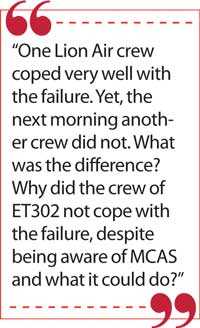Tuesday Mar 04, 2025
Tuesday Mar 04, 2025
Thursday, 18 April 2019 00:00 - - {{hitsCtrl.values.hits}}
The two recent crashes involving Boeing 737 MAX twin-engine jetliners have brought flight safety into sharper focus than ever after many decades.
This is in many ways a story of success breeding complacency. Airline safety has improved beyond belief, with many millions of flights operating daily with a near-perfect safety record. In fact, 2017 was the safest year ever, with not a single passenger death being caused in a jet aircraft accident.
Aircraft design processes, stringent regulations, engineering and maintenance, the evolution of navigation aids, safety protocols and procedures, have all contributed to making the airline industry a benchmark in the field of aviation. The handful of aircraft accidents that do occur, are largely a result of so-called “pilot error”.
Why did these new aircraft crash? 
One reason the two 737 MAX accidents have so gripped the world’s attention is that the fundamental cause appears to be in the design philosophy adopted by Boeing in order to bring this latest version of the ‘plane-making giant’s perennial favourite to market rapidly.
The MAX was a sales success until one day an obscure software ‘patch’ misbehaved in a manner that Boeing had never anticipated. On October 29 2018, Lion Air Flight 610, operated by a Boeing 737 MAX 8, crashed into the Java Sea shortly after departure, killing all 189 on board.
What is interesting though, is that the same aircraft had a similar problem the day before. However, on that occasion the crew dealt with the issue and landed safely. An extra pilot happened to be on the ‘jump-seat’ that day and assisted the crew in identifying the failure.
In fact, it has since been revealed that this was the fifth time in four days that Lion Air pilots encountered unexpected control inputs on this particular airplane. On four occasions it was dealt with successfully; on the fifth it was not.
What did the crew do wrong on the fatal flight?
Essentially, the crew of the fateful fifth flight did nothing wrong. In the 12 minutes they had after take-off, the pilots of Lion Air Flight 610 were unable to diagnose the problem involving a system (MCAS – Manoeuvring Characteristics Augmentation System) that they had no idea even existed.
The aviation community reacted swiftly and the US Federal Aviation Administration (FAA) put out an “Emergency Safety Bulletin” advising pilots about MCAS and how to deal with the failure.
Yet despite this knowledge, only five months later, Ethiopian Airlines Flight 302, also operated by a Boeing 737 MAX 8, crashed in very similar circumstances to that of Lion Air 610 shortly after departing Addis Ababa airport.
The preliminary report on this accident, which was released last week, shows that the Ethiopian crew correctly identified the problem and tried to apply the revised recovery procedures. But they failed to control the aircraft resulting in the crash, which killed all 157 people on board.
A recent report from Aviation Week states “Sources close to the investigation say data supports the supposition the aircraft’s left angle-of-attack sensor vane detached seconds after take-off and that, contrary to statements from the airline, the crew did not follow the correct steps in dealing with this unexpected failure [emphasis added].”
Is there a problem with the pilots or how they are trained?
This is one of the questions that have arisen from this pair of accidents. What part did the training and experience levels of the crews involved play in the outcome?
One Lion Air crew coped very well with the failure. Yet, the next morning another crew did not. What was the difference?
Why did the crew of ET302 not cope with the failure, despite being aware of MCAS and what it could do?
In this case it appears that the Captain was the youngest in Ethiopian’s cadre, while the First Officer was very new with a little over 300 flying hours to his credit. Was lack of experience a factor in this disaster, especially when faced with a ‘black swan’ event?
Where does the industry go from here? 
Modern aircraft (the MAX is not one) with their ‘fly by wire’ control systems, electronic checklists and computer-driven fault analysis, are a world apart from what this writer’s generation of pilots were initiated on. Thirty years after the introduction of highly automated aircraft, is it possible that the profession has lost the ‘muscle memory’ and analytic skills that were such a vital component of the job? Have we spawned an entire generation who can no longer fly by the ‘seat of their pants’?
A generation of pilots, who only ‘flew’ in the strictest sense as students, have spent their entire careers operating these modern machines. The system rewards procedural compliance and automation dependence. Has the industry erred in taking this path? Should it return to the basics and insist that ‘hand- flying’ skills be once again valued over the extensive use of automation?
More alarmingly, is the industry now attracting the wrong sort of candidate? Pilot organizations have done wonders in making the profession a well-paid and secure career. But has this meant that an intrinsic enthusiasm for flying, which motivated earlier generations to become aviators, is no longer there? Is the new ‘systems operator’ role of the pilot attracting young people who regard it as merely a lucrative and prestigious job, rather than a passion-driven profession?
Has the industry reduced experience levels below a safe level? The FAA requires a minimum of 1500 flying hours before a pilot can be a crewmember of a jet aircraft. Given that the USA has a large number of smaller airliners in service, gaining this level of flying experience in a few years is possible. But for the rest of the world, without a large ‘general aviation’ sector, it is difficult if not impossible to achieve.
Then again, the USA and Australia are the only exceptions in requiring this level of flying experience. The European regulator (EASA) is a proponent of what is known as the MPL (Multi-crew Pilot’s Licence) system that promotes low-time aviators operating in jet aircraft. There are no known safety implications with this system. With the huge growth in airline travel, there is already a growing pilot shortage. Enforcing a 1500-hour minimum worldwide would bring the industry practically to a halt.
So where does this leave us? Do we have to re-think the entire training system to restore safety levels to what we have become accustomed to?
Boeing must act urgently to restore the public’s confidence in its MAX generation of airliners. In the same way the entire industry – regulators, manufacturers and airlines – must review the methods and experience levels that are required to safely fly the complex aircraft being produced today. If not, the future of the airline industry could well be in jeopardy.
Discover Kapruka, the leading online shopping platform in Sri Lanka, where you can conveniently send Gifts and Flowers to your loved ones for any event including Valentine ’s Day. Explore a wide range of popular Shopping Categories on Kapruka, including Toys, Groceries, Electronics, Birthday Cakes, Fruits, Chocolates, Flower Bouquets, Clothing, Watches, Lingerie, Gift Sets and Jewellery. Also if you’re interested in selling with Kapruka, Partner Central by Kapruka is the best solution to start with. Moreover, through Kapruka Global Shop, you can also enjoy the convenience of purchasing products from renowned platforms like Amazon and eBay and have them delivered to Sri Lanka.
Discover Kapruka, the leading online shopping platform in Sri Lanka, where you can conveniently send Gifts and Flowers to your loved ones for any event including Valentine ’s Day. Explore a wide range of popular Shopping Categories on Kapruka, including Toys, Groceries, Electronics, Birthday Cakes, Fruits, Chocolates, Flower Bouquets, Clothing, Watches, Lingerie, Gift Sets and Jewellery. Also if you’re interested in selling with Kapruka, Partner Central by Kapruka is the best solution to start with. Moreover, through Kapruka Global Shop, you can also enjoy the convenience of purchasing products from renowned platforms like Amazon and eBay and have them delivered to Sri Lanka.